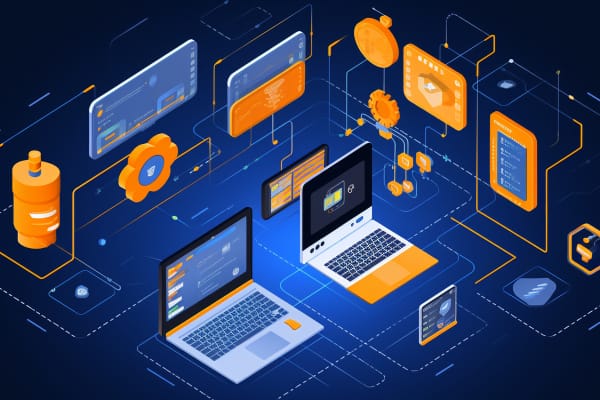What is SaaS?
Software as a Service (SaaS) represents a paradigm shift in how software is delivered, accessed, and used. At its core, SaaS is a method of delivering software applications over the internet, on a subscription basis. This model eliminates the need for organizations to install, manage, or maintain applications on individual computers or servers. Instead, SaaS providers host the applications on their own servers, ensuring that the software is available to their customers anywhere and anytime, provided there’s internet access.
Advantages of SaaS
- Cost-Effectiveness: SaaS eliminates the upfront cost of purchase/installation, ongoing costs like maintenance and upgrades, as well as the IT labor costs to manage the software.
- Accessibility and Flexibility: Users can access SaaS applications from any internet-connected device, offering greater flexibility in terms of when and where you can work.
- Scalability: SaaS providers typically offer various subscription options and flexibility to change subscriptions as and when needed, allowing businesses to scale services and features as required.
- Automatic Updates: The SaaS provider manages all updates and upgrades, eliminating the need for users to download or install patches.
- Security and Compliance: With SaaS, the responsibility of security and compliance is largely handled by the provider, ensuring that data is securely managed and regulatory compliances are met.

Lock In Our Lowest Price Ever For Only $14.99 Monthly Access
Your career in information technology last for years. Technology changes rapidly. An ITU Online IT Training subscription offers you flexible and affordable IT training. With our IT training at your fingertips, your career opportunities are never ending as you grow your skills.
Plus, start today and get 10 free days with no obligation.
Disadvantages of SaaS
- Control and Customization: SaaS applications might not offer the same level of customization or control as traditional software due to their one-size-fits-all approach.
- Data Security Concerns: As data is stored off-premises, usually hosted by the SaaS provider, concerns arise regarding data security and privacy.
- Performance Issues: Performance can be dependent on internet connection speed and reliability. Downtime or slow speeds can hinder productivity.
- Vendor Lock-in: Switching SaaS providers can be challenging, as data exportation and system reconfiguration can be complex and time-consuming.
Common Challenges
- Integration and Compatibility: Integrating SaaS applications with existing on-premises systems can be complex and may require additional software or services.
- Bandwidth and Latency: For businesses with a large number of users or those that require quick response times, bandwidth and latency can be a concern.
- Data Mobility and Ownership: Understanding and negotiating the terms of data ownership, mobility, and management is crucial to ensure data is handled according to the company’s policies.
- Compliance and Legal Issues: Ensuring that the SaaS provider is compliant with relevant laws and standards is essential, especially in industries that handle sensitive data.
Example SaaS Solutions
- Salesforce: A leading CRM platform offering a suite of enterprise applications focused on customer service, marketing automation, analytics, and application development. Visit Salesforce
- Google Workspace (Formerly G Suite): A collection of cloud computing, productivity, and collaboration tools that includes Gmail, Docs, Drive, Calendar, and more. Visit Google Workspace
- Microsoft Office 365: Provides cloud-based versions of traditional Microsoft software such as Word, Excel, PowerPoint, Outlook, and others. Visit Office 365
- Adobe Creative Cloud: Offers a collection of software for graphic design, video editing, web development, photography, and cloud services. Visit Adobe Creative Cloud
- Slack: A channel-based messaging platform that brings team communication and collaboration into one place, facilitating remote work and online workflows. Visit Slack
- Zoom: A remote conferencing services company that provides a reliable, video-first communications platform for meetings, webinars, and chat. Visit Zoom
- Dropbox: A file hosting service offering cloud storage, file synchronization, personal cloud, and client software, ideal for backup and sharing files. Visit Dropbox
- Shopify: A commerce platform that allows anyone to set up an online store and sell their products, also offering a range of services including payments, marketing, shipping, and customer engagement tools. Visit Shopify
- HubSpot: A developer and marketer of software products for inbound marketing, sales, and customer service, well known for its CRM platform. Visit HubSpot
- Atlassian: Offers a suite of productivity and development tools, including Jira for project management, Confluence for team collaboration, Bitbucket for source control, and more. Visit Atlassian
These platforms exemplify the versatility and wide range of services that SaaS can offer, catering to diverse needs from productivity and design to communication and e-commerce.

IT User Support Specialist Career Path
View our comprehensive training series covering all the key elements and certifications needed to successfully excel in an IT User Support Specialist job role.
Integrating and Extending SaaS Models Using APIs
The integration and extension of SaaS applications through APIs (Application Programming Interfaces) is a powerful approach that allows businesses to create a more connected, efficient, and customizable IT ecosystem. APIs act as bridges, allowing different software systems to communicate and work together. Here’s how APIs are transforming the way businesses use SaaS models:
Importance of APIs in SaaS
- Enhanced Connectivity: APIs allow SaaS applications to seamlessly connect with other services and systems, such as CRM, ERP, or marketing automation tools. This integration ensures that data flows smoothly across different parts of the business, providing a more unified view of operations.
- Customization and Personalization: APIs enable businesses to tailor SaaS applications to their specific needs. By using APIs, companies can add custom features or modify existing functionalities, ensuring that the software aligns perfectly with their workflows and processes.
- Automation of Tasks: Through API integration, routine tasks can be automated, reducing the need for manual input and minimizing the risk of human error. This automation not only saves time but also ensures that data remains consistent and up-to-date across all systems.
- Scalability: APIs allow businesses to easily add or remove features, integrate with new services, or scale their operations up or down. This flexibility is crucial for businesses looking to grow or adapt to changing market conditions.
Strategies for Integrating and Extending SaaS with APIs
- Identify Integration Points: Assess your current IT infrastructure and identify which systems and processes would benefit most from integration with your SaaS applications. Common integration points include customer data, order management, and communication platforms.
- Understand API Documentation: Thoroughly review the API documentation provided by the SaaS vendor. Understanding the capabilities, limitations, and the authentication mechanism is crucial for a successful integration.
- Ensure Data Security and Compliance: When integrating different systems, it’s vital to ensure that data security standards are upheld. Ensure that the APIs provide robust security features and that data transfer complies with relevant regulations like GDPR or HIPAA.
- Plan for Scalability and Maintenance: Ensure that your integration solution is scalable and maintainable. Consider how changes in one system (like updates or feature additions) will affect the integrated solution. Regularly review and update the integration as needed.
- Leverage Third-Party Integration Tools: If direct API integration is complex or beyond your technical capabilities, consider using third-party integration platforms. These platforms offer pre-built connectors and tools to facilitate integration without the need for extensive custom coding.
Integrating and extending SaaS models through APIs offers businesses unprecedented flexibility and efficiency. By allowing different systems to communicate and work together, APIs help create a more cohesive, responsive, and adaptable IT infrastructure. As the use of SaaS continues to grow, the role of APIs in enhancing and personalizing these services will only become more crucial. Whether you’re looking to streamline operations, ensure data consistency, or offer tailored services, APIs provide the tools necessary to turn these goals into reality.
The Future Outlook for SaaS
The future of SaaS looks promising and is poised for sustained growth. Factors driving this growth include:
- Continued Investment in AI and ML: Incorporation of AI and ML into SaaS products is likely to offer more personalized, efficient, and secure services.
- Expansion into New Markets: As internet connectivity improves globally, new markets are emerging, presenting opportunities for SaaS providers.
- Increased Focus on Vertical SaaS: More SaaS providers are expected to offer solutions tailored to specific industries, addressing unique industry challenges and requirements.
- Enhanced Collaboration Tools: The rise of remote work is driving the need for better collaboration tools, an area where SaaS can play a significant role.
- Emphasis on Security and Compliance: As cyber threats evolve, SaaS providers will likely enhance their security features and offer more robust compliance solutions.
In conclusion, SaaS has significantly transformed the way businesses operate, offering a more flexible, cost-effective, and scalable solution to traditional software. Despite the challenges, the advantages it brings, coupled with the continuous advancements in technology, make it a compelling choice for businesses of all sizes. As we look to the future, the evolution of SaaS is expected to further reshape the business landscape, driving innovation and growth across industries.
Frequently Asked Questions Related to SaaS (Software as a Service)
What is the primary difference between SaaS and traditional software?
The primary difference is that SaaS is hosted remotely on the provider’s servers and accessed over the internet, usually through a web browser. In contrast, traditional software is typically installed and runs on the user’s computer or on-premises servers. SaaS offers advantages in terms of accessibility, cost, and maintenance since the provider is responsible for updates, security, and infrastructure.
How does pricing typically work for SaaS products?
SaaS products usually operate on a subscription model. Customers pay a recurring fee, often monthly or annually, to use the software. This fee may vary based on the number of users, the level of service, the number of features required, or the amount of data being handled. Some SaaS products also offer a tiered pricing structure, where users can select from a range of packages with different feature sets and service levels.
Is data safe in a SaaS application?
Data security is a top priority for SaaS providers. Reputable SaaS products use strong encryption methods to protect data, both in transit and at rest. They also implement robust security measures, including regular security audits, compliance certifications, and data backup and recovery systems. However, it’s also important for users to adhere to best practices in security, such as using strong passwords and enabling two-factor authentication.
Can SaaS accommodate the specific needs of my business?
Many SaaS products are designed with flexibility and customization in mind. They offer a range of configurations and settings to cater to various business requirements. Additionally, most SaaS providers offer APIs (Application Programming Interfaces) and integration options that allow the SaaS product to work seamlessly with other tools and systems you may be using.
What happens if I decide to stop using a SaaS product?
If you decide to stop using a SaaS product, most providers offer options to export your data so that you can transition to another system. It’s important to review the terms of service and understand the data retention and export policies before subscribing to a SaaS product. Planning an exit strategy is crucial to ensure that you retain control and access to your data.
























